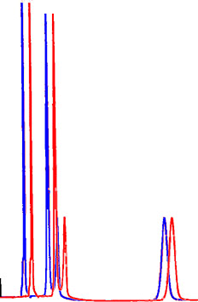Norbert Reuter*, Global Technical Support for CSD, Middelburg, The Netherlands
Like any other instrument an HPLC-System can run properly or not. In the first case everybody is happy and the best you can do is follow the old saying, "never touch a running system".
If the system is not properly running, you have to use "the art of HPLC troubleshooting" or sometimes even "the magic of HPLC troubleshooting". Fortunately, not all problems are hidden, and they show themselves in the produced chromatograms. Two common problems will be discussed in the following section:
Changing Retention Times
Longer Retention Times Than Expected
Question: You use the same instrument and you get the blue chromatogram in figure 1 first and later the red one, you changed nothing in your system. What is the problem?

Figure 1
Answer: Normally a leakage in or near the injector valve let you see this effect by reducing the effective flow through the column by bypassing eluent.
Shorter Retention Times Than Expected
Question: Let's assume 2 consecutive injections onto a normal phase column with chloroform/ethyl acetate as eluent. You got 2 chromatograms as drawn in figure 1, the red one is the first one. What happened?
Answer: Two things can happen, first the equilibration between column and eluent had not been finished and second your column temperature increased before the second run (higher temperatures decrease the eluent viscosity and therefore increase the column flow).
Peak Splitting
Question: You inject the same sample again after fixing all previous mentioned problems and you expect a nice 4-peak chromatogram, but you got the one in figure 2.

Figure 2
Answer: There are 3 possible faults: it could be a contamination of the column or guard column and you have to replace the guard column. If the problem still exists, your column could be plugged, and you have to follow the conditioning or recovery procedure mentioned in your column's manual. If the problem still exists, the inlet frit of your column could be plugged, and you have to remove it. There is still a chance that the problem persists, and it can only be solved by replacing the column.
